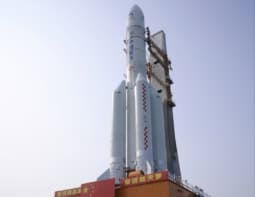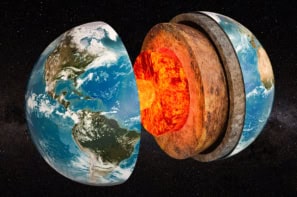The James Webb Space Telescope (JWST) is scheduled to launch on 25 December. To mark the event, Physics World is publishing a series of blog posts on the telescope’s technological innovations and scientific missions. This post is the first in the series.

Launch is usually the most dangerous part of a space mission. Once the payload has been hurled skyward atop a column of fire and reached space intact, mission scientists remember they’ve been holding their breath, and slowly exhale in relief.
Not so with the James Webb Space Telescope (JWST). For NASA’s latest and most expensive eye on the sky, launch on an Ariane 5 rocket will be the simple part. What comes next will determine whether the mission is a success or not. That’s because before it can push the envelope of what science and space technology can achieve, it must first overcome a dangerous deep-space deployment. During that deployment, if any of more than 300 things that could go wrong, do go wrong, the telescope’s capabilities will be limited at best. At worst, the entire instrument will be ruined.
This is the scale of the challenge facing the JWST after its launch, which – barring additional delays – is now scheduled for 25 December 2021. Should it succeed, it will transform astronomy. Should it fail, it could set the field back decades.
Part of the challenge has to do with the telescope’s size. At 6.5 metres, its primary mirror is the largest ever sent into space. “When we started off, we knew that we could more safely build a much smaller telescope,” says John Mather, the Nobel-prize-winning cosmologist who has been leading the project at NASA’s Goddard Space Flight Center since the mid-1990s. The problem, though, is that smaller wouldn’t cut it. Inspired by the Hubble Deep Field image of distant galaxies, Mather and his colleagues wondered what it would take to see even further back in time, to 300 million years after the Big Bang and some of the first galaxies that ever existed. The answer was a telescope of the JWST’s size.
“A heck of a lot of hard technical challenges”
Size isn’t the only tough requirement, though. The light from those early galaxies has been stretched by cosmic expansion. To see them, astronomers need a scope that can peer into near- and mid-infrared wavelengths. And to do that, the telescope needs to be stationed away from Earth’s thermal glow, around the L2 Lagrange point, with the Moon and Earth behind it – much too far for astronauts to reach it on a servicing mission.
There’s more. “The other thing that is challenging is that to reach the infrared sensitivity that we need, the telescope has to be very cold,” Mather says. “Pretty soon you have a heck of a lot of hard technical challenges.”
Thanks to these challenges, the launch date slipped, then slipped again and again while the cost of the mission went up and up. In 2011, with the telescope’s budget spiralling, the US House of Representatives moved to cancel it entirely, only for the troubled project to receive an eleventh-hour reprieve after scientists, the public and the media rallied to save it. As recently as 2018, when the budget was about to break the $8bn barrier, the US Congress had to vote to provide it with more funds.

NASA’s James Webb Space Telescope assembled for the first time
In the meantime, the mission’s science portfolio grew. In the mid-1990s, exoplanet science was in its infancy. Today we know of thousands of worlds beyond our solar system, and – all being well – the JWST will be in prime position to study their atmospheres. Similarly, a host of discoveries about the evolution of galaxies and how stars and planets form have raised new questions for the scope to answer. Should it come through its deployment successfully – its 6.5-metre segmented mirror unfolding correctly, its tennis court-sized sunshield unfurling without a hitch – then it will be ready to answer these questions and many more, utterly transforming astronomy in the process.
Despite the telescope’s hefty price tag and delayed launch, Lee Feinberg, the optical telescope element manager at NASA Goddard, is confident that it will be worth it. “There’s a couple of hundred scientific proposals [286 to be precise] that we’re going to do in the first year,” he tells Physics World, “and each one is at a level where they could justify a whole mission in themselves.”
Next: The JWST’s magnificent mirrors
- This article was amended on 22 December 2021 to reflect delays to the JWST’s launch date.



